Interview with Rebecca Shawcross
1May 31, 2013 by Ville Raivio
‘My name is Rebecca Shawcross and I am the Shoe Resources Officer at Northampton Museums & Art Gallery, which is part of Northampton Borough Council. I am in my 40s and have been in this post for the last 15 years. I have a honours degree in Anthropology and History of Art from Oxford Brookes University, a post graduate diploma in Museum Studies from St Andrews University and I am an AMA, which is an associate of the Museums Association. I have a partner and young daughter. They both visit Northampton Museum&Art Gallery on a regular basis to see the changing exhibitions and to look at the permanent shoe galleries. My partner has increased his passion for Puma trainers and my daughter loves to check on her favourite exhibits, including the elephant boot and stuffed animals posed as shoemakers!
Products from Pukimo Raivio
Ralph Lauren, Black Label suit, size 52EU
The Elephant Boot, which is one of four boots made by Lotus for the British Alpine Hannibal Expedition. The expedition aimed to recreate and track Hannibal’s route during his invasion of Italy in the 3rd Century BC. Often disputed by historians that the crossing actually took place, chroniclers reported that Hannibal crossed the Alps with 37 surviving elephants to take into battle. The British Alpine Hannibal Exhibition asked the question: Can an elephant cross the Alps? Turin Zoo was generous enough to provide the non-geological materials. Her name was Jumbo. Jumbo traveled 150 miles in 10 days from France to Susa in Italy. The result of the expedition’s experiment suggested that elephants can indeed cross the Alps. To protect Jumbo from the weather she had a canvas coat and trunk cover made and to protect her feet a set of canvas and leather boots. These boots were made by craftsmen at Lotus Ltd. using the patterns supplied. To find out the size of her feet the elephant stood on a large sheet of paper and someone drew round her feet. Unfortunately Jumbo was unable to finish the last eight kilometres of the expedition, as the track was considered unsafe.
The unique elephant boot, properly welted, of course
We have a model of a Shoemakers Shop with the figures made with stuffed squirrels and stoats. The squirrel is wearing an apron, with clamps between his knees on a shoemaker’s “seat”, the stoat is behind the counter clicking and another squirrel is carrying a mug of beer. It was made by renowned taxidermist Walter Potter and used as an advertisement in the window of Curtis, bespoke shoemaker and repairer, 107 Bostock Avenue, Northampton; 1860-1869. You either love it or loathe it!
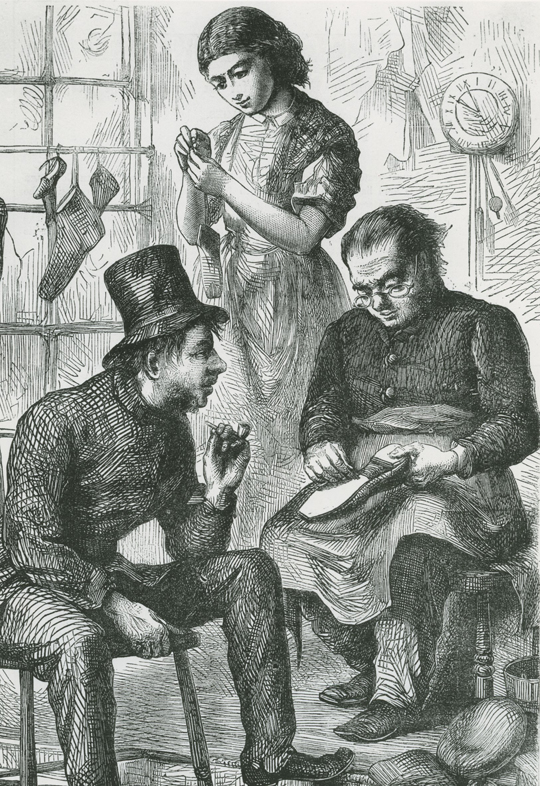 The Northampton Shoemaker, 1860
The Northampton Shoemaker, 1860
At the time I started several people did comment on how narrow a subject “just” shoes was, but having now been in the job for several years the subject of shoes is not a narrow one at all. When I got the job I think that the museum were not expecting to find anyone with an in-depth knowledge of shoes and their history, but what I did have was a good background in museums, including collections management, exhibition experience and good customer service skills. My knowledge of the history of shoe fashions, the industry in Northampton and further afield, the ability to date shoes and facilitate peoples’ enquiries whether they be “my grandfather was a shoemaker do you have any information on him?” to school children undertaking a project on shoes has developed over the years I’ve been in the job. Shoes do in fact cover quite a wide range of different areas including the industrial history, social history, the history of fashions and styles, the psychology of wearing shoes – what shoes express about ourselves, how they make us feel and such fascinating practises as concealed shoes.
Men’s black and red patent and morocco wellington boots, 1860s
I have developed my knowledge and experience of shoes and their history over many years and I am still developing it, and adding to it as it is a constant process. In terms of becoming familiar with different styles and being able to date historic footwear, there is nothing better than hands on work with the actual collection. The more shoes I see the more I increase my knowledge. I read books and try to keep up to date with new publications. I visit other shoe museums, museums that display shoes within their general displays and museums and art galleries for inspiration. I try to keep up to date with current shoe manufacturing, new innovations and developments. Over the years I have had some excellent advice from Miss June Swann the former shoe curator at Northampton Museums. She has spent 60 years in museums and specifically working with the shoe collection and now acts as an independent consultant. Her depth and breadth of knowledge is amazing.
Men’s gold leather Derby boots, Mounts Shoe Factory Co. Ltd., Northampton, 1922
I am obviously interested in fashion and shoes, but this I have to admit does not translate to my own dress! At the moment I’m wearing Dr Marten brogues. We are always looking to increase local, national and international visitors to the Museum and therefore the Shoe Collection and make what we have that is not on display accessible to researchers, designers and the generally interested visitor. Most museums are rather like icebergs. What you see on display is just the tip of it. We have 1,000 shoes on display at any one time and a further 12,000 in store. To give you a brief over view the Shoe Collection is part of Northampton Museums and Art Gallery, which is part of Northampton Borough Council. The Shoe Collection is just one collection the museum houses, the other collections include Fine and Decorative Arts, Geology, Costume, Social History, Military and Archaeology.
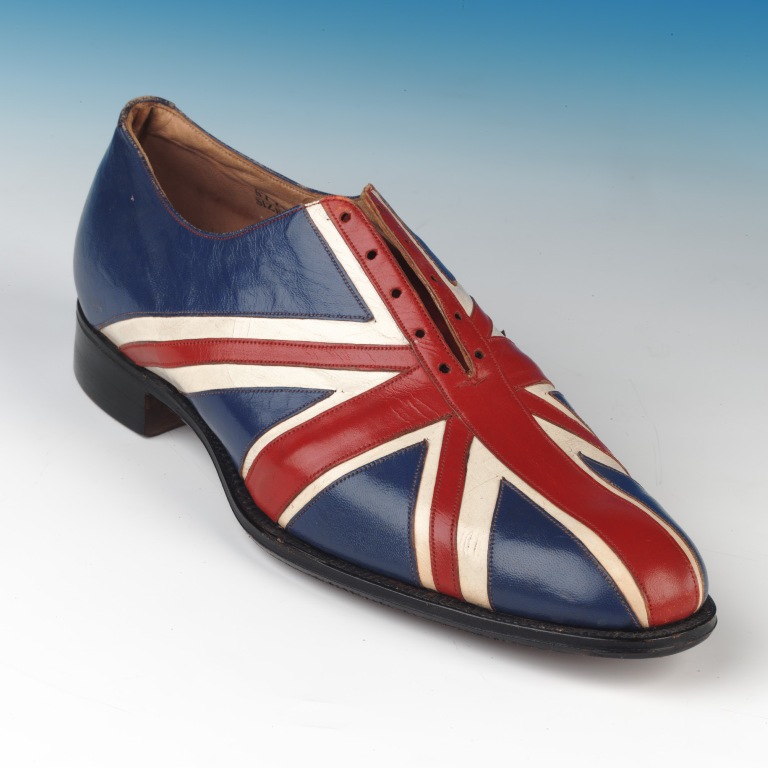 Union Jack oxfords made by George Webb to celebrate the Queen’s Coronation, 1953
Union Jack oxfords made by George Webb to celebrate the Queen’s Coronation, 1953
How many shoes are in its archives?
- Footwear, more than 12,000 items ranging from ancient Egyptian to contemporary design
- Accessories, including buckles, laces, shoe horns, trees, spats, leggings and polish
- Shoemaking tools, machines and components including lasts
- Retail trade material including shop furniture and fittings and advertising material
- Archive material including trade journals, company catalogues, books and photographs
- Fine and decorative art including paintings and prints depicting shoes and shoemaking
- Index of shoemakers and shoemaking firms from the Roman period onwards
- Index of concealed shoes hidden in buildings to bring good luck
- Specialist Reference Library
The Shoe Collection contains an extensive range of men’s footwear, largely influenced by the fact that Northampton as a shoemaking town has always been known for its manufacturer of men’s footwear, both domestic and military. In 1660 Thomas Fuller wrote that “the town of Northampton may be said to stand chiefly on other men’s legs…the most cheapest, if not the best, boots…in England are to be bought in Northampton.”
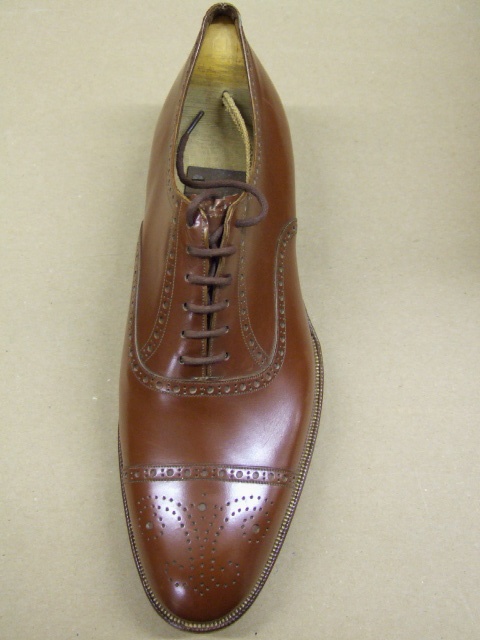 Men’s half-brogue oxfords, 1930s
Men’s half-brogue oxfords, 1930s
This emphasis is reflected in the men’s footwear collections which covers ready to wear and bespoke styles from 1600 to the present day, a good collection of military footwear, particularly from World War One and Two, catalogues of men’s footwear from 1900 onwards, and examples of Northampton town and county-made high-end footwear, including examples from current local manufacturers like Jeffery-West, Church and Co. Ltd., Tricker’s and Crockett and Jones who have worldwide renown.
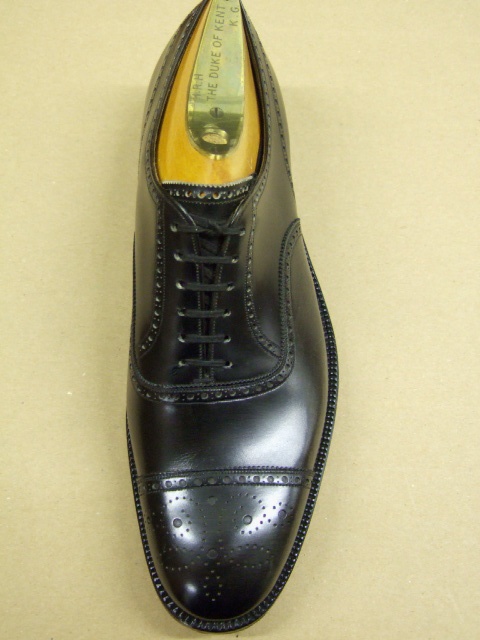 The Duke of Kent’s half-brogue oxfords, 1930s
The Duke of Kent’s half-brogue oxfords, 1930s
When you look back over the years, then men’s shoe styles have had mixed fortunes. Quite early on men had some of the most amazing footwear. The medieval poulaine was a flat soled slip on shoe with a pointed toe worn by both men and women, but men took the toe to extreme. The toe on men’s footwear increased and increased in length so much so they had to roll the toes up to aid walking! The long pointed toe was a sign of status and perhaps an indicator of the wearer’s masculinity! Portraits from the 17th century show men wearing the most fabulous shoe creations, sporting high heels, spangles and lace. By the end of the 19th century many shoes and boots worn by men conformed to one of two basic styles, the Oxford or Oxford brogue and the Derby. Even today many men’s footwear is based on these two styles. Of course Northampton is still the home to shoe factories and companies producing top end high quality men’s footwear that has a world-wide reputation, much of what is still produced are the classic Oxford, Oxford brogue, Derby and Monk styles.
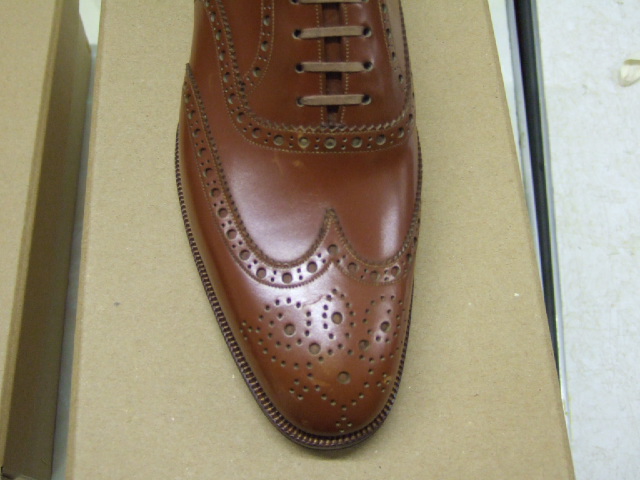 Men’s full-brogue medallion and toe shape, 1940s
Men’s full-brogue medallion and toe shape, 1940s
It is very hard to pick out favourites from the men’s shoe collection, I’m usually torn between those unassuming men’s shoes that have a great story attached to them or the really amazing one off pairs like the pair made by George Webb for the Queen’s Coronation in 1953. We accepted as a donation a few years ago a pair of black leather Oxfords that under usual circumstances we would have probably said no to but they come with an amazing history attached to them. In brief they were bought by the donors father in the 1920s and then worn at his wedding in 1923. They were worn at many functions and loaned to the donor when he attended school dances in the 1950s. On the death of his father the donor inherited them and wore them at his own wedding in the early 1920s. He too wore them at many functions including those held at Buckingham Palace and Westminster. He finally donated them to the Shoe Collection because they had become uncomfortable to wear. So they look like a dull pair of shoes, but in fact have a great history to them.
Men’s brown leather and white suede co-respondent Oxford shoe,
Rice & Hutchins, USA, circa 1930
We have two permanent shoes galleries for readers to visit. The Life and Sole gallery highlights the history of shoes and shoemaking, as well as such topics such as Looking after your Shoes, Shoe Mending and Shoes made for Special Purposes. The Followers of Fashion gallery deals with fashion and design and highlights some of the recurring themes in fashionable footwear. We also have a changing programme of temporary shoe exhibitions in our shoe gallery and shoe lounge. At the moment we have an exhibition of photographs showing the working lives of shoemakers working at Alfred Sargent at Earls Barton and a small display of footwear from Walsh Casuals. These will be followed by an exhibition looking at all things Mod including footwear and a small display highlighting the work Sheffield University have undertaken on understanding why we wear the shoes that we do and how shoes influence how we feel about ourselves.
Men’s blue and beige leather co-respondent Oxford shoes,
Mounts Shoe Factory Co. Ltd., Northampton, 1922-29
Highlights of the collection include a boot made for Jumbo the elephant, the stilts in the shape of a pair of Doc Martens made for Elton John to wear in the Pinball Wizard sequence in the film of ‘Tommy, A Rock Opera’, a pair of blue velvet shoes embroidered in gold made about 1660, the shoes Queen Victoria wore on her wedding day in 1840, shoes by top end designers such as Manolo Blahnik and Jimmy Choo and a pair of Super Elevated Ghillies by Vivienne Westwood (the style that caused Naomi Campbell’s downfall in 1994).
Men’s tan leather Oxford shoes, Pollard&Sons, Northampton, 1910
I love “stuff” and clearly don’t get enough of it working in a museum, so I enjoy trawling antique fairs, visiting country houses and National Trust properties and travelling abroad whenever I can. A good-looking, well-made pair of shoes should be considered a wise investment and really does get you noticed. Don’t always stick with black or brown shoes, a little colour works, too.’
http://www.northampton.gov.uk/museums
More examples of the museum’s unique collection can be found at Flickr.
Pictures: © The Northampton Shoe Museum
Category Arbiter Elegantiae, Interviews, Northampton | Tags:

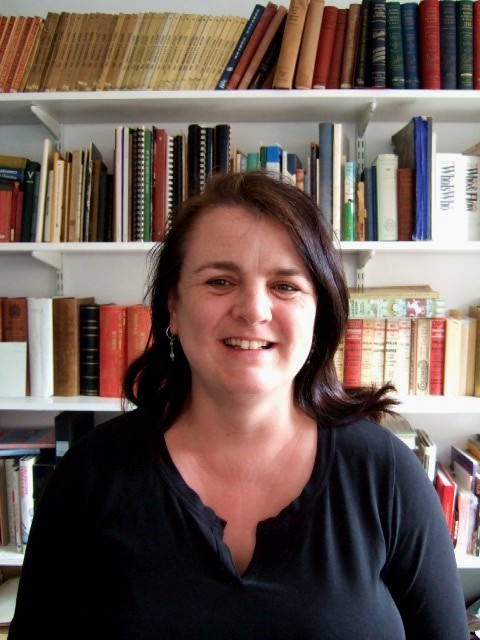
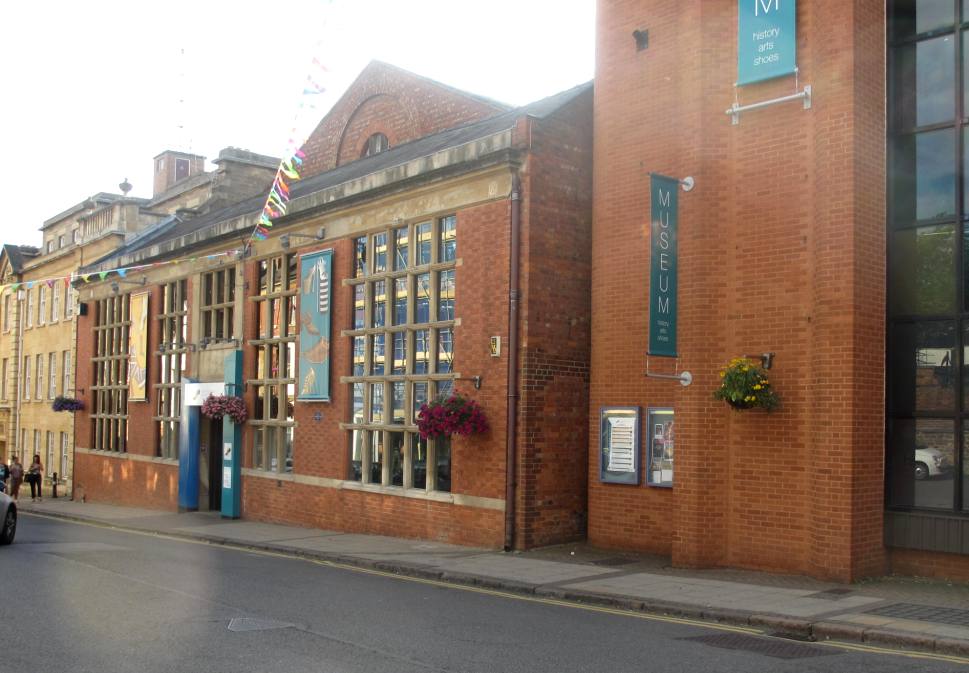
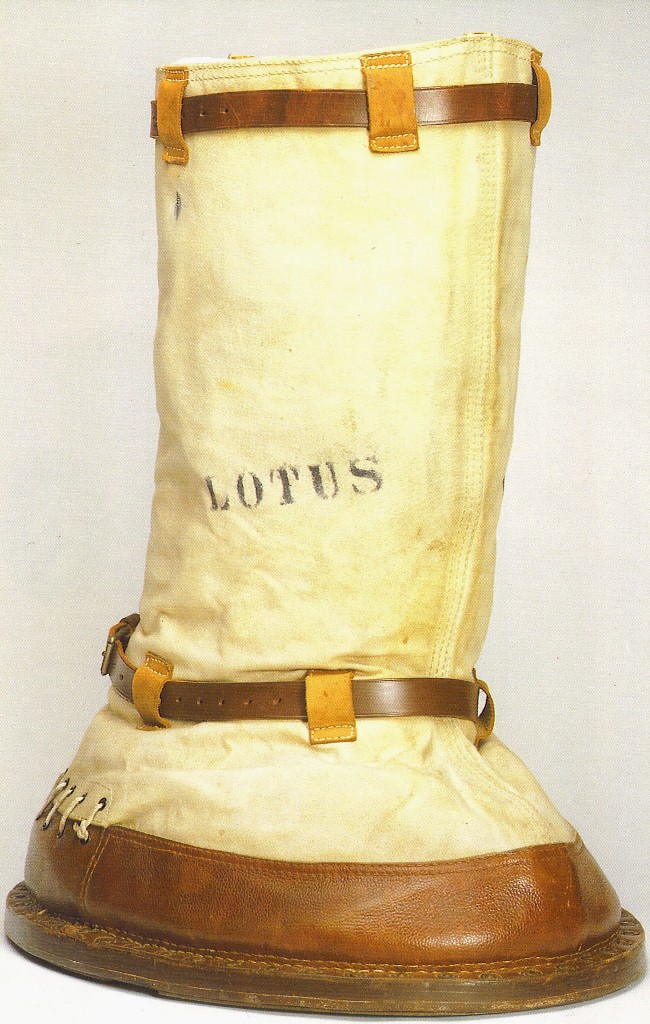
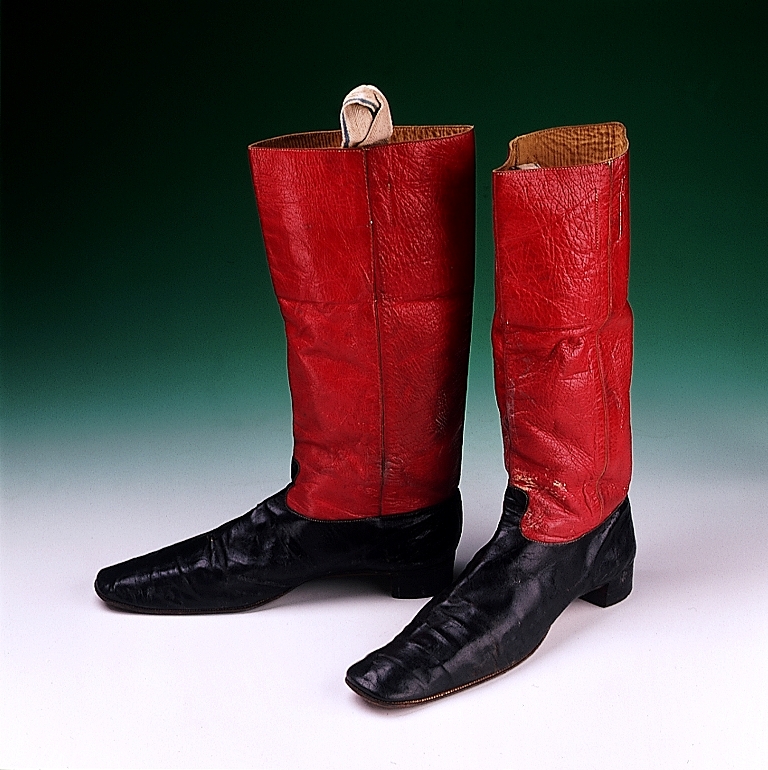
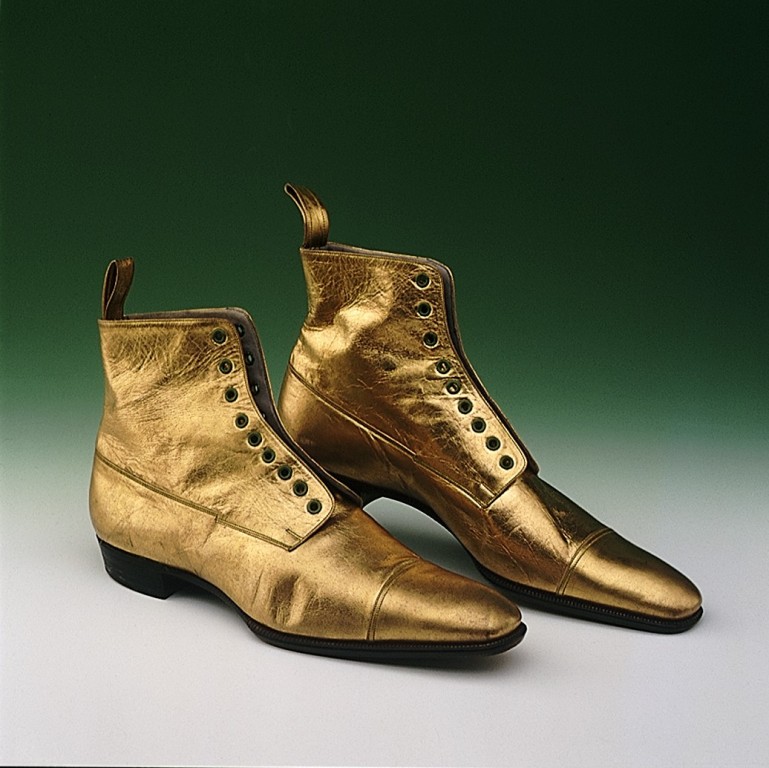
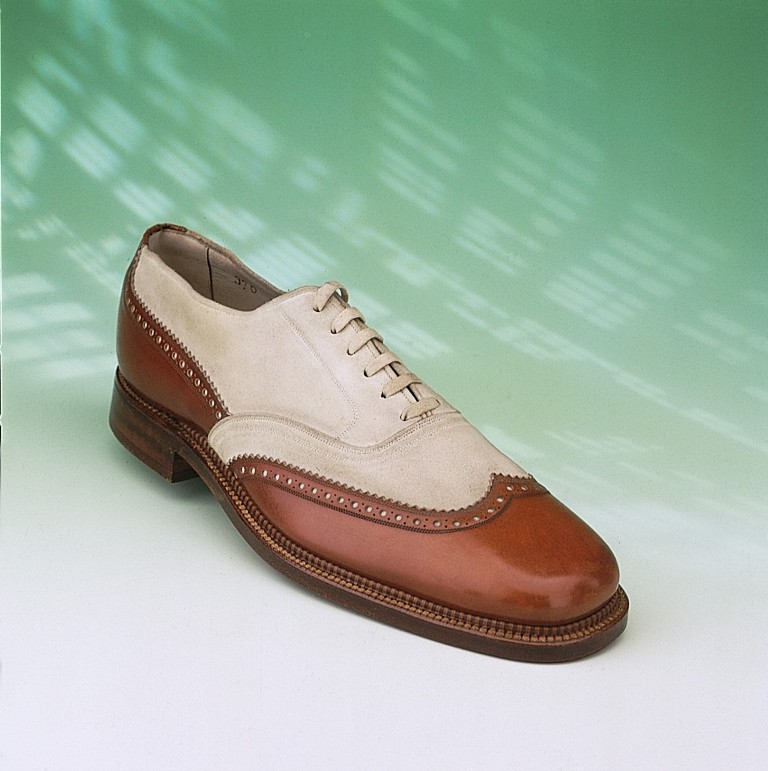
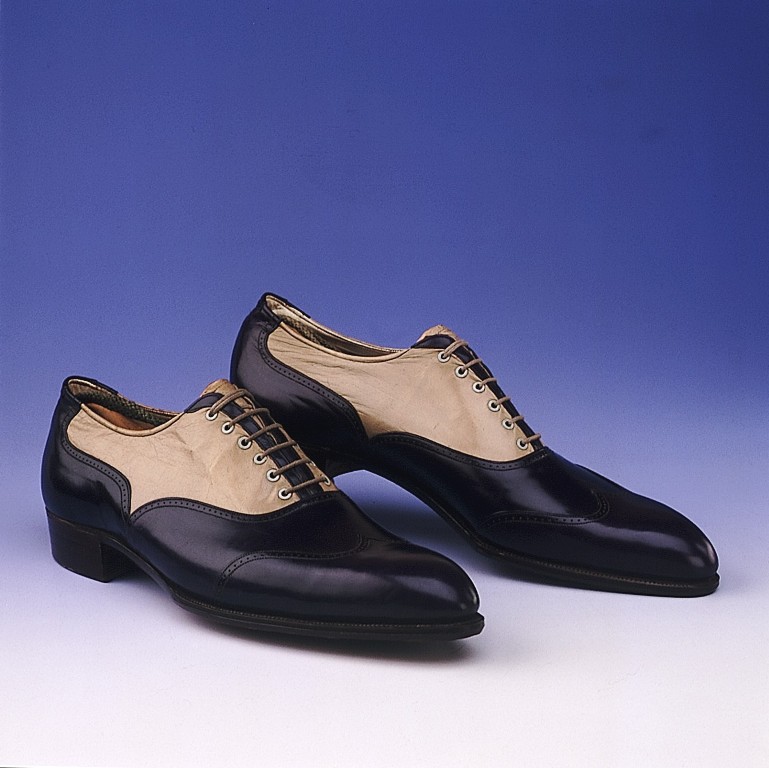
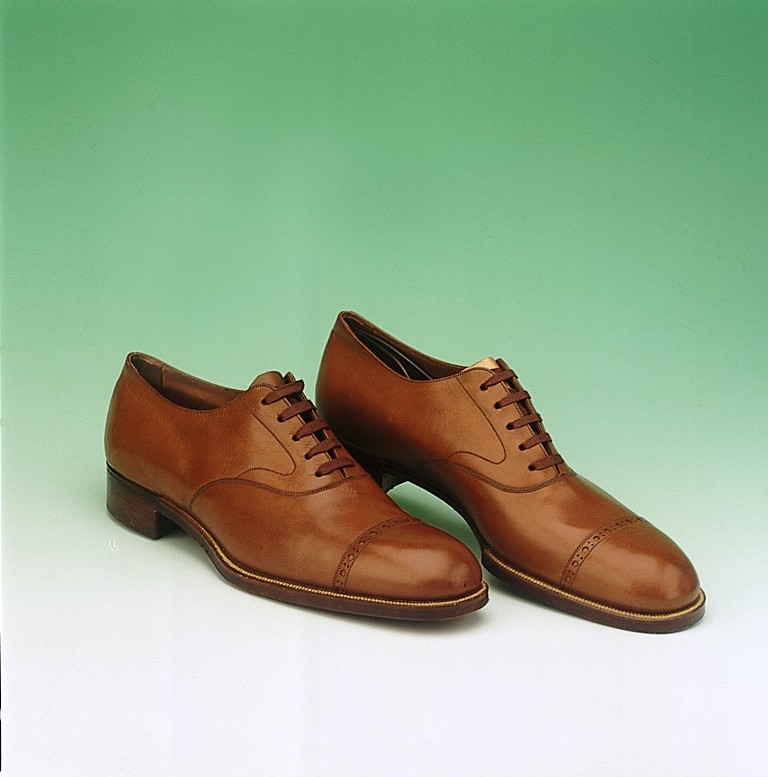


[…] published by John Lobb (Paris) in four parts, with consulting from Rebecca Shawcross from the Northampton Shoe […]